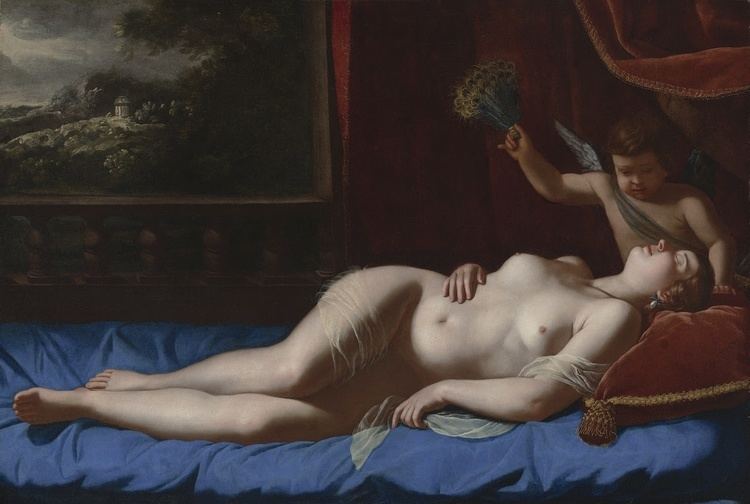Artist Artemisia Gentileschi Period Baroque Media Paint, Oil paint | Created 1625–1630 Genre History painting | |
 | ||
Location Virginia Museum of Fine Arts Similar Artemisia Gentileschi artwork, Baroque artwork, Oil paintings | ||
Venus and Cupid (Sleeping Venus) was painted by Artemisia Gentileschi from 1625-1627 in Italy. Venus and Cupid is a depiction of a sleeping Venus, who reclines on a blue bed covering and rich crimson and gold tasseled pillow. She wears nothing except a thin wisp of transparent linen around her thigh. Her son Cupid fans her with richly colored peacock feathers as she drifts to sleep. He is gazing at her with an adored, raptured expression. In the background, there is a window looking out onto a moonlight landscape where a temple to the goddess lies. Venus’s face has full cheeks, heavy lids, a prominent nose, and small protruding chin—all features of Gentileschi's own face. The body movements are natural: Venus’s hand rests lightly on her side, her legs are gently laid together. The work blends together realism and classicism through its iconography and the artist’s style.
Influences
Artemisia Gentileschi's artistic style was heavily influenced by her father Orazio Gentileschi. Artemisia worked under her father in his work shop, learning from him. Ignoring the conventions of the time, Orazio sent his daughter to study under his friend Agostino Tassi. Tassi, however, sexually assaulted Gentileschi throughout her tutelage. Although she did take him to court and Tassi was found guilty and exiled, Gentileschi's reputation was effected negatively. Her rape had a large effect on her career and artistic style. Many of her early works, such as Judith Slaying Holofernes reflect her anger towards Tassi and his actions. Some scholars have noted that her works have often been interpreted in regards to her rape and pursuing trial with Tassi. Furthermore, both Artemisia and her father were followers of Caravaggio, and the contrasts of dark and light that Caravaggio and his followers were known for is evident in both paintings.
